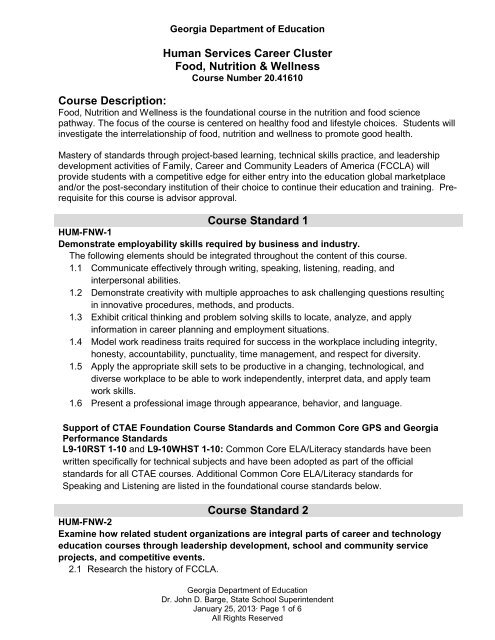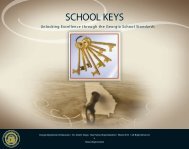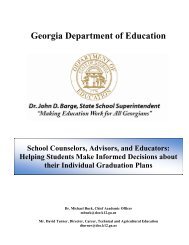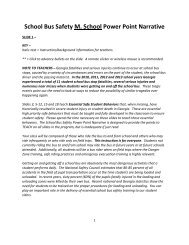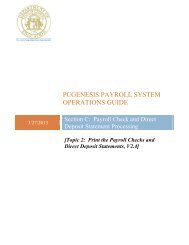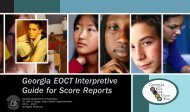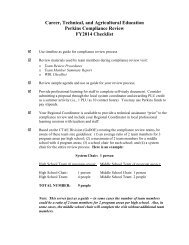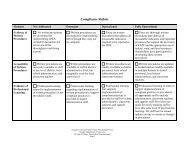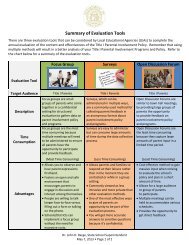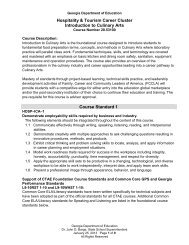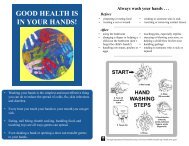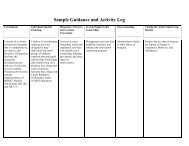Foods, Nutrition and Wellness - Georgia Department of Education
Foods, Nutrition and Wellness - Georgia Department of Education
Foods, Nutrition and Wellness - Georgia Department of Education
Create successful ePaper yourself
Turn your PDF publications into a flip-book with our unique Google optimized e-Paper software.
<strong>Georgia</strong> <strong>Department</strong> <strong>of</strong> <strong>Education</strong><br />
Human Services Career Cluster<br />
Food, <strong>Nutrition</strong> & <strong>Wellness</strong><br />
Course Number 20.41610<br />
Course Description:<br />
Food, <strong>Nutrition</strong> <strong>and</strong> <strong>Wellness</strong> is the foundational course in the nutrition <strong>and</strong> food science<br />
pathway. The focus <strong>of</strong> the course is centered on healthy food <strong>and</strong> lifestyle choices. Students will<br />
investigate the interrelationship <strong>of</strong> food, nutrition <strong>and</strong> wellness to promote good health.<br />
Mastery <strong>of</strong> st<strong>and</strong>ards through project-based learning, technical skills practice, <strong>and</strong> leadership<br />
development activities <strong>of</strong> Family, Career <strong>and</strong> Community Leaders <strong>of</strong> America (FCCLA) will<br />
provide students with a competitive edge for either entry into the education global marketplace<br />
<strong>and</strong>/or the post-secondary institution <strong>of</strong> their choice to continue their education <strong>and</strong> training. Prerequisite<br />
for this course is advisor approval.<br />
Course St<strong>and</strong>ard 1<br />
HUM-FNW-1<br />
Demonstrate employability skills required by business <strong>and</strong> industry.<br />
The following elements should be integrated throughout the content <strong>of</strong> this course.<br />
1.1 Communicate effectively through writing, speaking, listening, reading, <strong>and</strong><br />
interpersonal abilities.<br />
1.2 Demonstrate creativity with multiple approaches to ask challenging questions resulting<br />
in innovative procedures, methods, <strong>and</strong> products.<br />
1.3 Exhibit critical thinking <strong>and</strong> problem solving skills to locate, analyze, <strong>and</strong> apply<br />
information in career planning <strong>and</strong> employment situations.<br />
1.4 Model work readiness traits required for success in the workplace including integrity,<br />
honesty, accountability, punctuality, time management, <strong>and</strong> respect for diversity.<br />
1.5 Apply the appropriate skill sets to be productive in a changing, technological, <strong>and</strong><br />
diverse workplace to be able to work independently, interpret data, <strong>and</strong> apply team<br />
work skills.<br />
1.6 Present a pr<strong>of</strong>essional image through appearance, behavior, <strong>and</strong> language.<br />
Support <strong>of</strong> CTAE Foundation Course St<strong>and</strong>ards <strong>and</strong> Common Core GPS <strong>and</strong> <strong>Georgia</strong><br />
Performance St<strong>and</strong>ards<br />
L9-10RST 1-10 <strong>and</strong> L9-10WHST 1-10: Common Core ELA/Literacy st<strong>and</strong>ards have been<br />
written specifically for technical subjects <strong>and</strong> have been adopted as part <strong>of</strong> the <strong>of</strong>ficial<br />
st<strong>and</strong>ards for all CTAE courses. Additional Common Core ELA/Literacy st<strong>and</strong>ards for<br />
Speaking <strong>and</strong> Listening are listed in the foundational course st<strong>and</strong>ards below.<br />
Course St<strong>and</strong>ard 2<br />
HUM-FNW-2<br />
Examine how related student organizations are integral parts <strong>of</strong> career <strong>and</strong> technology<br />
education courses through leadership development, school <strong>and</strong> community service<br />
projects, <strong>and</strong> competitive events.<br />
2.1 Research the history <strong>of</strong> FCCLA.<br />
<strong>Georgia</strong> <strong>Department</strong> <strong>of</strong> <strong>Education</strong><br />
Dr. John D. Barge, State School Superintendent<br />
January 25, 2013∙ Page 1 <strong>of</strong> 6<br />
All Rights Reserved
<strong>Georgia</strong> <strong>Department</strong> <strong>of</strong> <strong>Education</strong><br />
2.2 Discuss the mission, purpose, motto, colors, <strong>of</strong>ficial dress <strong>and</strong> other distinguishing<br />
characteristics <strong>of</strong> FCCLA.<br />
2.3 Explain how participation in FCCLA can promote lifelong responsibility for community<br />
service <strong>and</strong> pr<strong>of</strong>essional growth <strong>and</strong> development<br />
2.4 Create a personal leadership plan to participate in programs, conferences, community<br />
service <strong>and</strong> competitive events on the local, state, <strong>and</strong> national level that align with the<br />
competencies, skills <strong>and</strong> knowledge <strong>of</strong> this course.<br />
Support <strong>of</strong> CTAE Foundation Course St<strong>and</strong>ards <strong>and</strong> Common Core GPS <strong>and</strong> <strong>Georgia</strong><br />
Performance St<strong>and</strong>ards<br />
ELACC9-10SL1: Initiate <strong>and</strong> participate effectively in a range <strong>of</strong> collaborative discussions(oneon-one,<br />
in groups, <strong>and</strong> teacher-led) with diverse partners on grades 9–10 topics, texts, <strong>and</strong><br />
issues, building on others’ ideas <strong>and</strong> expressing their own clearly <strong>and</strong> persuasively.<br />
ELACC9-10SL4: Present information, findings, <strong>and</strong> supporting evidence clearly, concisely, <strong>and</strong><br />
logically such that listeners can follow the line <strong>of</strong> reasoning <strong>and</strong> the organization, development,<br />
substance, <strong>and</strong> style are appropriate to purpose, audience, <strong>and</strong> task.<br />
Course St<strong>and</strong>ard 3<br />
HUM-FNW-3<br />
Analyze factors that influence food choices <strong>and</strong> quality <strong>of</strong> diet.<br />
3.1 Explain how physical factors influence food choices <strong>and</strong> quality <strong>of</strong> diet.<br />
3.2 Explain how emotional factors influence food choices <strong>and</strong> quality <strong>of</strong> diet.<br />
3.3 Predict how psychological factors influence food choices <strong>and</strong> quality <strong>of</strong> diet.<br />
3.4 Predict how intellectual factors influence food choices <strong>and</strong> quality <strong>of</strong> diet.<br />
3.5 Research how spiritual, religious, cultural, <strong>and</strong> family customs influence food choices <strong>and</strong><br />
quality <strong>of</strong> diet.<br />
3.6 Research government <strong>and</strong> legislation, (i.e. FSIS, USDA, FDA, GRAS, Delaney Clause),<br />
influence food choices <strong>and</strong> quality <strong>of</strong> diet.<br />
3.7 Compare economic factors that influence food choices <strong>and</strong> quality <strong>of</strong> diet.<br />
3.8 Examine how environmental factors influence food choices <strong>and</strong> quality <strong>of</strong> diet.<br />
Support <strong>of</strong> CTAE Foundation Course St<strong>and</strong>ards <strong>and</strong> Common Core GPS <strong>and</strong> <strong>Georgia</strong><br />
Performance St<strong>and</strong>ards<br />
ELACC9-10SL1: Initiate <strong>and</strong> participate effectively in a range <strong>of</strong> collaborative discussions(oneon-one,<br />
in groups, <strong>and</strong> teacher-led) with diverse partners on grades 9–10 topics, texts, <strong>and</strong><br />
issues, building on others’ ideas <strong>and</strong> expressing their own clearly <strong>and</strong> persuasively.<br />
ELACC9-10SL2: Integrate multiple sources <strong>of</strong> information presented in diverse media or formats<br />
(e.g., visually, quantitatively, orally) evaluating the credibility <strong>and</strong> accuracy <strong>of</strong> each source.<br />
ELACC9-10SL4: Present information, findings, <strong>and</strong> supporting evidence clearly, concisely, <strong>and</strong><br />
logically such that listeners can follow the line <strong>of</strong> reasoning <strong>and</strong> the organization, development,<br />
substance, <strong>and</strong> style are appropriate to purpose, audience, <strong>and</strong> task.<br />
Course St<strong>and</strong>ard 4<br />
HUM-FNW-4<br />
Evaluate nutritional information in relation to wellness for individuals <strong>and</strong> families.<br />
4.1 Identify basic nutrient information i.e. nutrient classes <strong>and</strong> major sources <strong>of</strong> each.<br />
4.2 Analyze the Dietary Guidelines for Americans, Dietary Recommended Intake, <strong>and</strong> My<br />
Plate.<br />
<strong>Georgia</strong> <strong>Department</strong> <strong>of</strong> <strong>Education</strong><br />
Dr. John D. Barge, State School Superintendent<br />
January 25, 2013∙ Page 2 <strong>of</strong> 6<br />
All Rights Reserved
<strong>Georgia</strong> <strong>Department</strong> <strong>of</strong> <strong>Education</strong><br />
4.3 Compare <strong>and</strong> analyze food labels <strong>and</strong> nutrition facts panels on food products.<br />
4.4 Compare portion sizes in different food categories.<br />
4.5 Determine the allowable amount <strong>of</strong> trans fats in foods.<br />
4.6 Discuss the use <strong>of</strong> additives <strong>and</strong> controlled substances.<br />
4.7 Examine the regulation <strong>of</strong> herbal supplements.<br />
4.8 Analyze reliable sources <strong>of</strong> nutrition information.<br />
Support <strong>of</strong> CTAE Foundation Course St<strong>and</strong>ards <strong>and</strong> Common Core GPS <strong>and</strong> <strong>Georgia</strong><br />
Performance St<strong>and</strong>ards<br />
ELACC9-10SL1: Initiate <strong>and</strong> participate effectively in a range <strong>of</strong> collaborative discussions(oneon-one,<br />
in groups, <strong>and</strong> teacher-led) with diverse partners on grades 9–10 topics, texts, <strong>and</strong><br />
issues, building on others’ ideas <strong>and</strong> expressing their own clearly <strong>and</strong> persuasively.<br />
ELACC9-10SL2: Integrate multiple sources <strong>of</strong> information presented in diverse media or formats<br />
(e.g., visually, quantitatively, orally) evaluating the credibility <strong>and</strong> accuracy <strong>of</strong> each source.<br />
ELACC9-10SL4: Present information, findings, <strong>and</strong> supporting evidence clearly, concisely, <strong>and</strong><br />
logically such that listeners can follow the line <strong>of</strong> reasoning <strong>and</strong> the organization, development,<br />
substance, <strong>and</strong> style are appropriate to purpose, audience, <strong>and</strong> task.<br />
Course St<strong>and</strong>ard 5<br />
HUM-FNW-5<br />
Analyze the effects <strong>of</strong> food eating behaviors on wellness.<br />
5.1 Compare <strong>and</strong> contrast healthy eating habits <strong>and</strong> practices.<br />
5.2 Determine healthy strategies to gain, lose <strong>and</strong> maintain weight.<br />
5.3 Examine traits, examples <strong>and</strong> health risks <strong>of</strong> fad diets.<br />
5.4 Determine types <strong>and</strong> symptoms <strong>of</strong> eating disorders.<br />
5.5 Compare <strong>and</strong> analyze financial <strong>and</strong> personal consequences from food related illnesses.<br />
5.6 Determine strategies to lower intake <strong>of</strong> fat, sodium, caffeine <strong>and</strong> sugar.<br />
5.7 Determine strategies to avoid/prevent cancer, heart disease, obesity, <strong>and</strong> common<br />
nutrient deficiencies.<br />
5.8 Examine the role <strong>of</strong> artificial sweeteners.<br />
Support <strong>of</strong> CTAE Foundation Course St<strong>and</strong>ards <strong>and</strong> Common Core GPS <strong>and</strong> <strong>Georgia</strong><br />
Performance St<strong>and</strong>ards<br />
ELACC9-10SL1: Initiate <strong>and</strong> participate effectively in a range <strong>of</strong> collaborative discussions(oneon-one,<br />
in groups, <strong>and</strong> teacher-led) with diverse partners on grades 9–10 topics, texts, <strong>and</strong><br />
issues, building on others’ ideas <strong>and</strong> expressing their own clearly <strong>and</strong> persuasively.<br />
ELACC9-10SL2: Integrate multiple sources <strong>of</strong> information presented in diverse media or formats<br />
(e.g., visually, quantitatively, orally) evaluating the credibility <strong>and</strong> accuracy <strong>of</strong> each source.<br />
ELACC9-10SL4: Present information, findings, <strong>and</strong> supporting evidence clearly, concisely, <strong>and</strong><br />
logically such that listeners can follow the line <strong>of</strong> reasoning <strong>and</strong> the organization, development,<br />
substance, <strong>and</strong> style are appropriate to purpose, audience, <strong>and</strong> task.<br />
Course St<strong>and</strong>ard 6<br />
HUM-FNW-6<br />
Investigate the health <strong>and</strong> nutrition requirements <strong>of</strong> individuals <strong>and</strong> families with special<br />
needs.<br />
6.1 Determine the health <strong>and</strong> nutrition requirements <strong>of</strong> athletes, young children <strong>and</strong> older<br />
adults.<br />
<strong>Georgia</strong> <strong>Department</strong> <strong>of</strong> <strong>Education</strong><br />
Dr. John D. Barge, State School Superintendent<br />
January 25, 2013∙ Page 3 <strong>of</strong> 6<br />
All Rights Reserved
<strong>Georgia</strong> <strong>Department</strong> <strong>of</strong> <strong>Education</strong><br />
6.2 Determine the health <strong>and</strong> nutrition requirements for vegetarians <strong>and</strong> people with food<br />
allergens.<br />
Course St<strong>and</strong>ard 7<br />
HUM-FNW-7<br />
Analyze food safety <strong>and</strong> sanitation practices from production to consumption.<br />
7.1 Demonstrate proper sanitation practices (e.g. h<strong>and</strong> washing, BAC guidelines).<br />
7.2 Underst<strong>and</strong> the requirements <strong>of</strong> food temperatures <strong>and</strong> food safety.<br />
7.3 Demonstrate the need <strong>of</strong> safe food h<strong>and</strong>ling practices.<br />
7.4 Develop sanitation practices that apply to the Hazard Analysis <strong>and</strong> Critical Control<br />
Point (HACCP) system.<br />
7.5 Demonstrate the need <strong>of</strong> safe food storage practices.<br />
7.6 Develop appropriate activities regarding the safe use <strong>of</strong> equipment.<br />
7.7 Underst<strong>and</strong> the Health <strong>Department</strong> Inspection procedures <strong>and</strong> regulations.<br />
Support <strong>of</strong> CTAE Foundation Course St<strong>and</strong>ards <strong>and</strong> Common Core GPS <strong>and</strong> <strong>Georgia</strong><br />
Performance St<strong>and</strong>ards<br />
ELACC9-10SL1: Initiate <strong>and</strong> participate effectively in a range <strong>of</strong> collaborative discussions(oneon-one,<br />
in groups, <strong>and</strong> teacher-led) with diverse partners on grades 9–10 topics, texts, <strong>and</strong><br />
issues, building on others’ ideas <strong>and</strong> expressing their own clearly <strong>and</strong> persuasively.<br />
ELACC9-10SL4: Present information, findings, <strong>and</strong> supporting evidence clearly, concisely, <strong>and</strong><br />
logically such that listeners can follow the line <strong>of</strong> reasoning <strong>and</strong> the organization, development,<br />
substance, <strong>and</strong> style are appropriate to purpose, audience, <strong>and</strong> task.<br />
Course St<strong>and</strong>ard 8<br />
HUM-FNW-8<br />
Compare the causes <strong>and</strong> foods at risk for illnesses.<br />
8.1 Distinguish causes <strong>and</strong> differences in food borne illnesses (e.g. but not limited to:<br />
Clostridium botulinum, Clostridium perfingens, Escherichia coli, Listeria<br />
monocytogenes, staphylococcus aureus, salmonella, hepatitis, <strong>and</strong> trichinosis).<br />
8.2 Underst<strong>and</strong> the causes <strong>of</strong> food contaminants.<br />
8.3 Identify the potentially hazardous foods <strong>and</strong> causes.<br />
8.4 Determine the effect <strong>of</strong> ingredients on microbes, processing time <strong>and</strong>/or temperature.<br />
8.5 Identify safety nets <strong>and</strong> identify resources to combat food borne illnesses i.e. FDA.<br />
Support <strong>of</strong> CTAE Foundation Course St<strong>and</strong>ards <strong>and</strong> Common Core GPS <strong>and</strong> <strong>Georgia</strong><br />
Performance St<strong>and</strong>ards<br />
ELACC9-10SL1: Initiate <strong>and</strong> participate effectively in a range <strong>of</strong> collaborative discussions(oneon-one,<br />
in groups, <strong>and</strong> teacher-led) with diverse partners on grades 9–10 topics, texts, <strong>and</strong><br />
issues, building on others’ ideas <strong>and</strong> expressing their own clearly <strong>and</strong> persuasively.<br />
ELACC9-10SL4: Present information, findings, <strong>and</strong> supporting evidence clearly, concisely, <strong>and</strong><br />
logically such that listeners can follow the line <strong>of</strong> reasoning <strong>and</strong> the organization, development,<br />
substance, <strong>and</strong> style are appropriate to purpose, audience, <strong>and</strong> task.<br />
SMI3: Students will examine different ways in which microbial cells generate energy for growth<br />
<strong>and</strong> reproduction.<br />
b. Describe how microorganisms differ with respect to their nutritional requirements for<br />
growth.<br />
<strong>Georgia</strong> <strong>Department</strong> <strong>of</strong> <strong>Education</strong><br />
Dr. John D. Barge, State School Superintendent<br />
January 25, 2013∙ Page 4 <strong>of</strong> 6<br />
All Rights Reserved
<strong>Georgia</strong> <strong>Department</strong> <strong>of</strong> <strong>Education</strong><br />
Course St<strong>and</strong>ard 9<br />
HUM-FNW-9<br />
Evaluate scientific <strong>and</strong> technical advances in food processing, storage, product<br />
development <strong>and</strong> distribution for nutrition <strong>and</strong> wellness.<br />
9.1 Explain scientific methods <strong>and</strong> hypothesis testing.<br />
9.2 Explain organically grown foods.<br />
9.3 Discuss <strong>and</strong> explain concentrated foods.<br />
9.4 Give examples on the effects <strong>of</strong> food density, shape <strong>and</strong> size, <strong>and</strong> amount <strong>of</strong> food.<br />
9.5 Investigate strategies to increase the food supply, sustain the food supply, <strong>and</strong> protect<br />
the food supply.<br />
9.6 Define the role <strong>of</strong> technology in exp<strong>and</strong>ing the food supply.<br />
Support <strong>of</strong> CTAE Foundation Course St<strong>and</strong>ards <strong>and</strong> Common Core GPS <strong>and</strong> <strong>Georgia</strong><br />
Performance St<strong>and</strong>ards<br />
ELACC9-10SL1: Initiate <strong>and</strong> participate effectively in a range <strong>of</strong> collaborative discussions(oneon-one,<br />
in groups, <strong>and</strong> teacher-led) with diverse partners on grades 9–10 topics, texts, <strong>and</strong><br />
issues, building on others’ ideas <strong>and</strong> expressing their own clearly <strong>and</strong> persuasively.<br />
ELACC9-10SL2: Integrate multiple sources <strong>of</strong> information presented in diverse media or formats<br />
(e.g., visually, quantitatively, orally) evaluating the credibility <strong>and</strong> accuracy <strong>of</strong> each source.<br />
ELACC9-10SL4: Present information, findings, <strong>and</strong> supporting evidence clearly, concisely, <strong>and</strong><br />
logically such that listeners can follow the line <strong>of</strong> reasoning <strong>and</strong> the organization, development,<br />
substance, <strong>and</strong> style are appropriate to purpose, audience, <strong>and</strong> task.<br />
SCSh3: Students will identify <strong>and</strong> investigate problems scientifically.<br />
a. Suggest reasonable hypotheses for identified problems.<br />
b. Develop procedures for solving scientific problems.<br />
c. Collect, organize <strong>and</strong> record appropriate data.<br />
d. Graphically compare <strong>and</strong> analyze data points <strong>and</strong>/or summary statistics.<br />
e. Develop reasonable conclusions based on data collected.<br />
f. Evaluate whether conclusions are reasonable by reviewing the process <strong>and</strong> checking<br />
against other available information.<br />
Course St<strong>and</strong>ard 10<br />
HUM-FNW-10<br />
Design <strong>and</strong> demonstrate ability to select, store, prepare <strong>and</strong> serve nutritious, safe <strong>and</strong><br />
appealing foods.<br />
10.1 Determine the equivalents <strong>and</strong> measuring techniques for serving nutritious, safe <strong>and</strong><br />
appealing foods.<br />
10.2 Identify sources <strong>of</strong> nutritious, safe <strong>and</strong> appealing locally grown foods.<br />
10.3 Demonstrate safe food practices for cooking outdoors.<br />
10.4 Demonstrate the selection, storage, <strong>and</strong> cooking techniques for meats <strong>and</strong> meat<br />
products.<br />
10.5 Demonstrate the selection, storage, <strong>and</strong> cooking techniques for dairy products.<br />
10.6 Demonstrate the selection, storage, <strong>and</strong> cooking techniques for grains <strong>and</strong> starches.<br />
10.7 Demonstrate the selection, storage, <strong>and</strong> cooking techniques for fruits.<br />
10.8 Demonstrate the selection, storage <strong>and</strong> cooking techniques for vegetables.<br />
10.9 Apply different food service styles to menu planning.<br />
<strong>Georgia</strong> <strong>Department</strong> <strong>of</strong> <strong>Education</strong><br />
Dr. John D. Barge, State School Superintendent<br />
January 25, 2013∙ Page 5 <strong>of</strong> 6<br />
All Rights Reserved
<strong>Georgia</strong> <strong>Department</strong> <strong>of</strong> <strong>Education</strong><br />
Support <strong>of</strong> CTAE Foundation Course St<strong>and</strong>ards <strong>and</strong> Common Core GPS <strong>and</strong> <strong>Georgia</strong><br />
Performance St<strong>and</strong>ards<br />
ELACC9-10SL1: Initiate <strong>and</strong> participate effectively in a range <strong>of</strong> collaborative discussions(oneon-one,<br />
in groups, <strong>and</strong> teacher-led) with diverse partners on grades 9–10 topics, texts, <strong>and</strong><br />
issues, building on others’ ideas <strong>and</strong> expressing their own clearly <strong>and</strong> persuasively.<br />
ELACC9-10SL2: Integrate multiple sources <strong>of</strong> information presented in diverse media or formats<br />
(e.g., visually, quantitatively, orally) evaluating the credibility <strong>and</strong> accuracy <strong>of</strong> each source.<br />
ELACC9-10SL4: Present information, findings, <strong>and</strong> supporting evidence clearly, concisely, <strong>and</strong><br />
logically such that listeners can follow the line <strong>of</strong> reasoning <strong>and</strong> the organization, development,<br />
substance, <strong>and</strong> style are appropriate to purpose, audience, <strong>and</strong> task.<br />
Course St<strong>and</strong>ard 11<br />
HUM-FNW-11<br />
Research careers related to food, nutrition <strong>and</strong> wellness.<br />
11.1 Identify foods <strong>and</strong> nutrition careers in the government, business, media, educational,<br />
<strong>and</strong> healthcare sectors <strong>and</strong> list the educational requirements for those identified.<br />
11.2 Examine the job market at a local, state <strong>and</strong> regional level.<br />
11.3 Analyze how studying foods <strong>and</strong> nutrition now can benefit one in the future.<br />
Support <strong>of</strong> CTAE Foundation Course St<strong>and</strong>ards <strong>and</strong> Common Core GPS <strong>and</strong> <strong>Georgia</strong><br />
Performance St<strong>and</strong>ards<br />
ELACC9-10SL1: Initiate <strong>and</strong> participate effectively in a range <strong>of</strong> collaborative discussions(oneon-one,<br />
in groups, <strong>and</strong> teacher-led) with diverse partners on grades 9–10 topics, texts, <strong>and</strong><br />
issues, building on others’ ideas <strong>and</strong> expressing their own clearly <strong>and</strong> persuasively.<br />
<strong>Georgia</strong> <strong>Department</strong> <strong>of</strong> <strong>Education</strong><br />
Dr. John D. Barge, State School Superintendent<br />
January 25, 2013∙ Page 6 <strong>of</strong> 6<br />
All Rights Reserved


